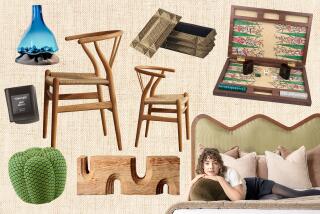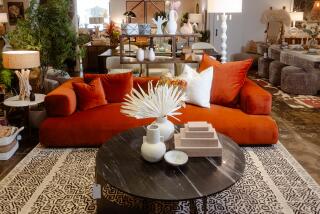Furniture’s Fashion Statement--Made in Plastic
From refrigerator containers to carpets, plastics are part of almost every aspect of home life. But few of us probably spend much time thinking about their aesthetics.
It was different in the 1960s, when bright, space-age-looking plastic furniture, accessories and small appliances burst upon the scene.
“Plastics like melamine, acrylics, ABS and PVC, perfected during World War II, freed the imaginations of designers around the world to create objects that had no historic precedent,” Scott Reilly says.
Reilly is the curator of a lively museum exhibition called “Pop Goes the Plastic,” now in New York. The small but colorful show, which originated at the Atlanta International Museum earlier this year, is at the Katonah Museum of Art in New York through Nov. 29.
The exhibition, subtitled “The Visual and Cultural Esthetic of a New Technology 1960-1975,” documents the era in which plastic home furnishings became a style statement.
“While plastics weren’t new in the ‘60s, technological advances and the introduction of injection molds allowed for the mass production of large items by around 1960,” Reilly says.
The promise of mass production led designers of plastic furnishings to believe they could realize a dream of modernism and make interesting designs for the masses.
The dream failed.
The designs were not especially affordable because they were made in small quantities. Items by top names, mainly Italians, were costly to import. Perhaps even more disappointing to the designers, most people didn’t want them.
“Inflate, assemble, use and throw away were the operative terms from the designers’ point of view,” Reilly says. “From the point of view of many consumers, home furnishings were not something to be used and discarded.”
By 1973, Pop Art, the space race and the youth rebellion--all of which played a role in the plastics aesthetic--were fading, and so were plastic home furnishings.
The energy crisis drove prices even higher. The American bicentennial celebration and the environmental movement of the ‘70s, both emphasizing natural materials and tradition, further hobbled futuristic design.
“Earth tones were in, and avocado replaced lime green; yellow became gold; orange became rust, and black became brown,” the curator says.
Still, Reilly does not consider the plastics design movement of the ‘60s a failure.
“It enabled designers to create provocative, imaginative, technologically advanced objects that challenged consumers to think about the ways they saw and used objects,” he says.
The reasons that designers loved plastic home furnishings are still with us. Plastics can be molded into useful, practical shapes and colored brightly to satisfy the desire for novelty. They are light, easy to move and rearrange. Modular units of plastic can be added to as they needed. If inexpensive enough, they are disposable.
One proof that designers were onto something is that home furnishings they produced are now collectible.
“Plastics from the ‘60s do really well with younger consumers who may have seen them on MTV and on television shows about the future,” says Jim Walrod, co-owner of Form & Function, a specialty store in lower Manhattan. “Even today, nothing as advanced is on the market, so the shows use these pieces on their sets.”
Artifacts are being sold not only in antiques specialty stores. See-through blow-up chairs, molded stacking chairs, storage holders and small tables similar to the ones in the exhibit are for sale around the country at mid-price emporiums and in mail-order catalogs.
Urban Outfitters--a chain of 29 home furnishings stores around the country, including stores in Costa Mesa, San Diego and Santa Monica--is selling see-through inflatable chairs and sofas similar to those of the 1960s and ‘70s.
“Our target market is 18- to 24-year-olds in cities, and inflatable furniture is very popular with them,” says Gwen Duser, a merchandising executive with the chain, headquartered in Philadelphia.
“Young people have a lifestyle that requires that they be able to move their belongings frequently. The mobility of blow-up furniture appeals to them. The price point--all items are under $100--also is part of the attraction.”
The Katonah Museum of Art is on Route 22 in Katonah, N.Y. (914) 232-9555.
More to Read
The biggest entertainment stories
Get our big stories about Hollywood, film, television, music, arts, culture and more right in your inbox as soon as they publish.
You may occasionally receive promotional content from the Los Angeles Times.










